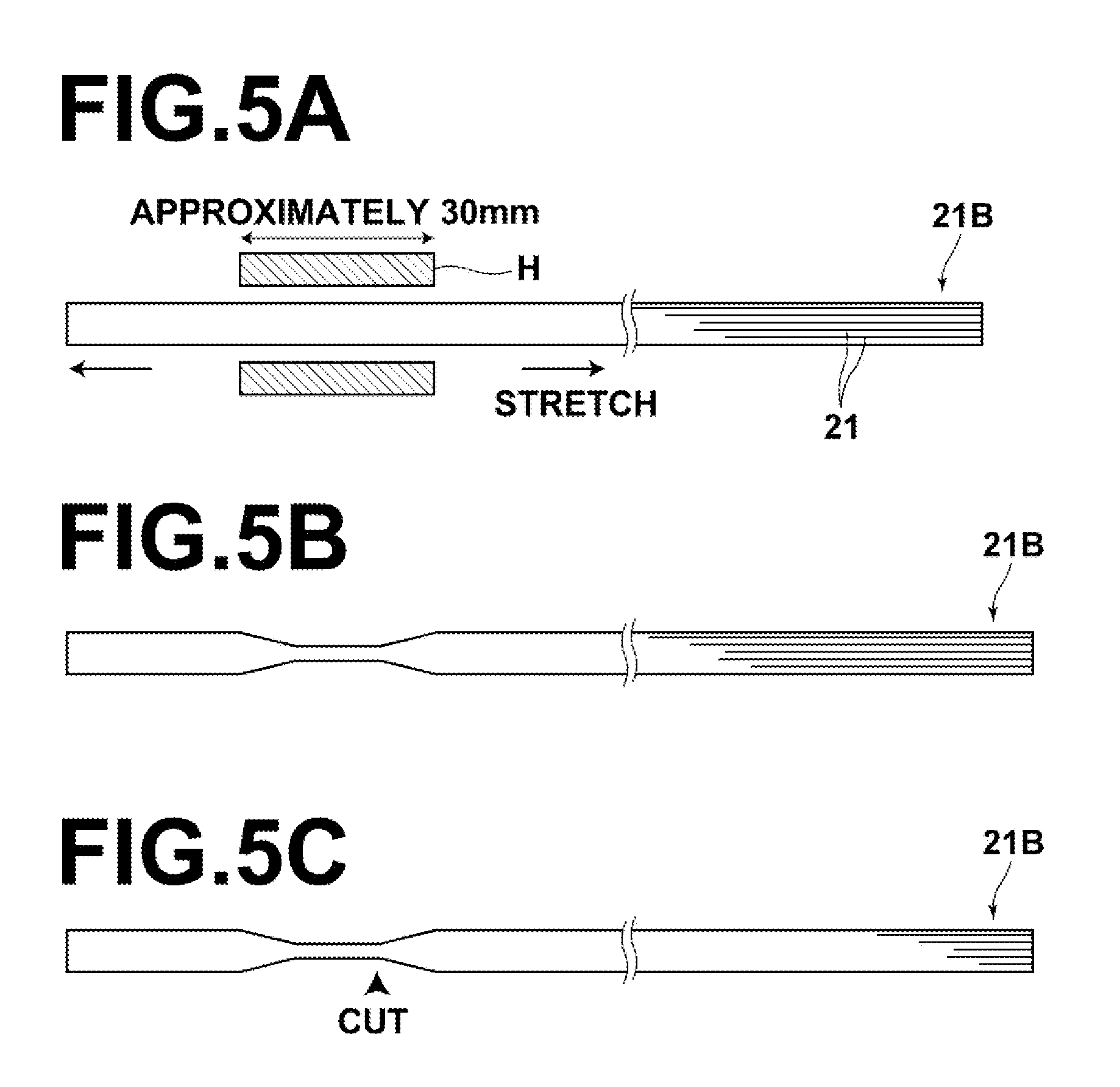Light guide for endoscopes
a technology of endoscopes and light guides, which is applied in the field of light guides for endoscopes, can solve the problems of deterioration of the durability of the light guides, inability to meet the needs of patients, and easy breakage of optical fibers, so as to achieve greater light utilization efficiency, greater illumination range, and greater apertures.
- Summary
- Abstract
- Description
- Claims
- Application Information
AI Technical Summary
Benefits of technology
Problems solved by technology
Method used
Image
Examples
first embodiment
[0042]FIG. 1 is a side view that illustrates a light guide 10 for endoscopes according to the present invention. The light guide 10 for endoscopes is constituted by a plurality of bundled multi mode optical fibers 11 having comparatively large diameters, and a plurality of bundled multi mode optical fibers 21 having comparatively small diameters, connected to the multi mode optical fibers 11. A first end portion of the bundled multi mode optical fibers 11 (the left end portion in FIG. 1) and a second end portion of the bundled multi mode optical fibers 11 (the right end portion in FIG. 1) are housed in cylindrical connector housings 13 and 14, respectively, and fixed therein by filling adhesive 12. Similarly, a first end portion of the multi mode optical fibers 21 (the left end portion in FIG. 1) and a second end portion of the multi mode optical fibers 21 (the right end portion in FIG. 1) are housed in cylindrical connector housings 14 and 15, respectively, and fixed therein by fil...
second embodiment
[0055]In the light guide for endoscopes 30 of the second embodiment as well, the portion in the vicinity of the light output end thereof is constituted by the comparatively small diameter multi mode optical fibers 21. Therefore, this portion can be flexed at smaller radii of curvature. On the other hand, the base portion of the light guide for endoscopes 30, at which flexibility is not required, is constituted by the comparatively large diameter multi mode optical fibers 11, thereby improving the durability thereof.
[0056]Further, the glass rod 16 is utilized at the light input portion of the light guide for endoscopes 30 in a similar manner to the light guide for endoscopes 10 of the first embodiment. Accordingly, the same advantageous effects which are obtained by the light guide for endoscopes 10 of the first embodiment are also obtained by the light guide for endoscopes 30 of the second embodiment.
[0057]Next, a method for forming the light output portions of the plurality of mult...
third embodiment
[0059]In the light guide for endoscopes 40 of the third embodiment as well, the portion in the vicinity of the light output end thereof is constituted by the comparatively small diameter multi mode optical fibers 21. Therefore, this portion can be flexed at smaller radii of curvature. On the other hand, the base portion of the light guide for endoscopes 40, at which flexibility is not required, is constituted by the comparatively large diameter multi mode optical fibers 11, thereby improving the durability thereof.
[0060]In addition, in the light guide for endoscopes 40 of the third embodiment, the first end portion of the multi mode optical fibers 11, which is the light input portion where the illuminating light beam 7 enters, and the second end portion of the multi mode optical fibers 21, which is the light output portion where the illuminating light beam 7 is output, are both of tapered shapes. Therefore, the illuminating light beam enters the light input portion at a high utiliza...
PUM
 Login to View More
Login to View More Abstract
Description
Claims
Application Information
 Login to View More
Login to View More - R&D
- Intellectual Property
- Life Sciences
- Materials
- Tech Scout
- Unparalleled Data Quality
- Higher Quality Content
- 60% Fewer Hallucinations
Browse by: Latest US Patents, China's latest patents, Technical Efficacy Thesaurus, Application Domain, Technology Topic, Popular Technical Reports.
© 2025 PatSnap. All rights reserved.Legal|Privacy policy|Modern Slavery Act Transparency Statement|Sitemap|About US| Contact US: help@patsnap.com



